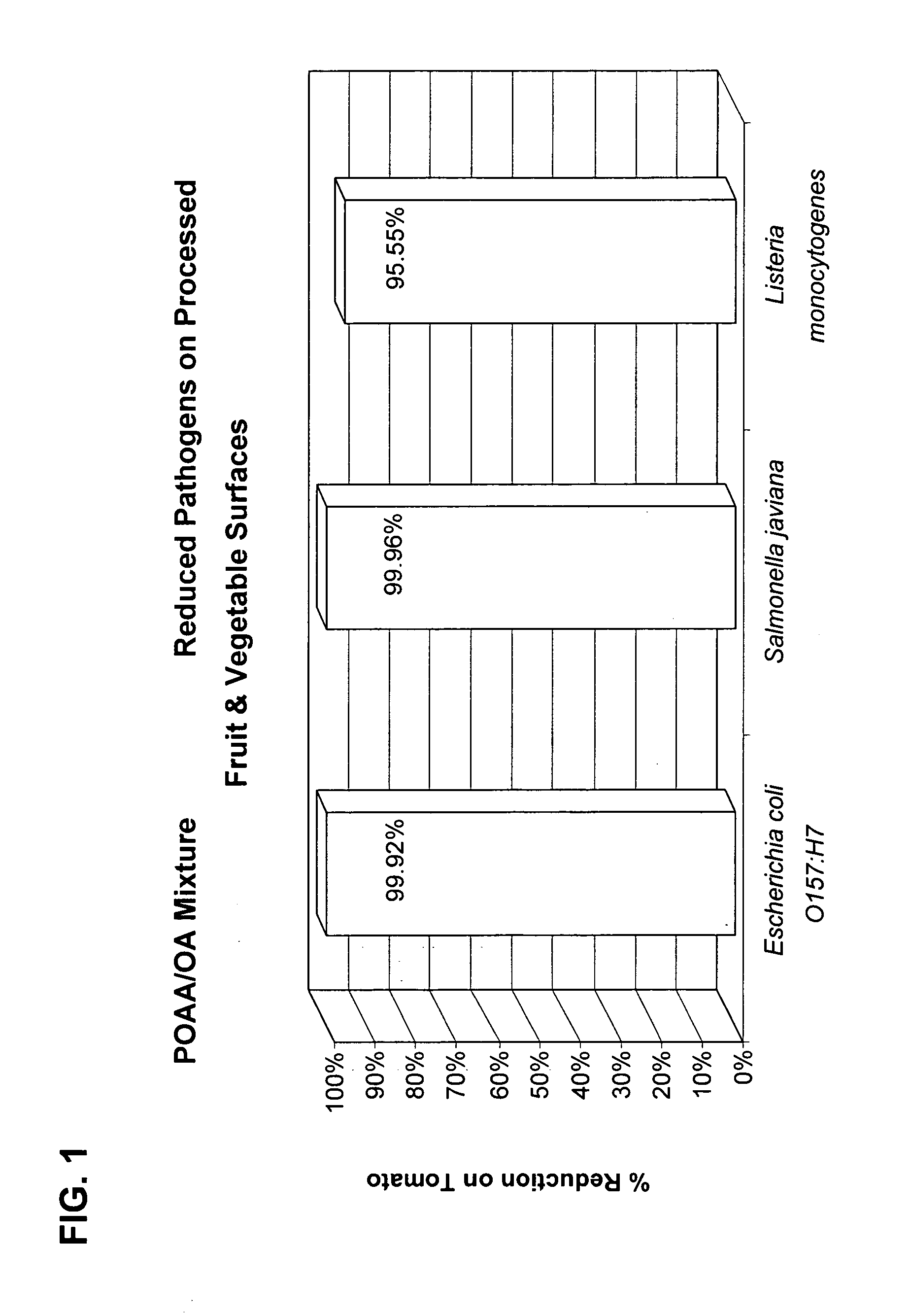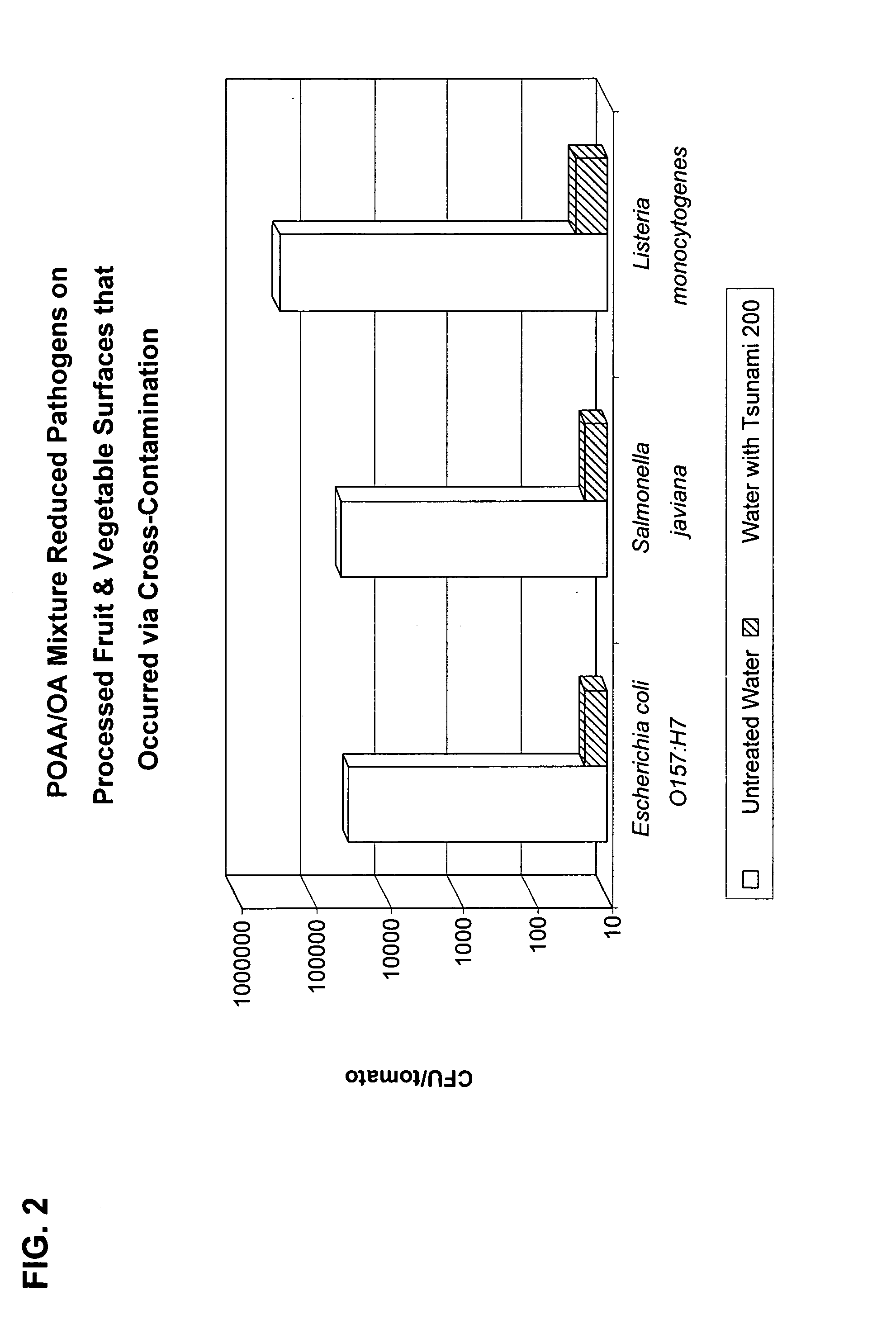Composition for inhibition of microbial growth
a technology of microbial growth and composition, applied in the direction of biocide, animal repellents, drug compositions, etc., can solve the problems of increased microbial populations, untreated and recycled water during transport or processing accumulates debris, and is subject to organic and microbial contamination, so as to achieve safe ingestibility and high antimicrobial
- Summary
- Abstract
- Description
- Claims
- Application Information
AI Technical Summary
Benefits of technology
Problems solved by technology
Method used
Image
Examples
example 1
for Peroxyacetic / Peroxyoctanoic Acid Mixtures Having Activity Against Microbes Contaminating Fruits and Vegetables
[0055]A preferred antimicrobial concentrate composition of the invention was formulated as:
[0056]
Raw MaterialWeight %Glacial Acetic Acid54Hydrogen Peroxide, 35%30HEDP, 60%1Octanoic Acid, 95%15
[0057]This concentrate formulation converted to a composition including peroxy acids during storage for two weeks at generally ambient conditions. In this case, the concentrate composition converted to:
[0058]
Typical Weight Percent of Chemical InChemicalConcentrate 2 Weeks Post-ManufactureAcetic Acid40%Hydrogen Peroxide 5%HEDP0.6%Octanoic Acid10%Peroxyacetic Acid12%Peroxyoctanoic Acid 3%
The remainder of this concentrate composition was water.
[0059]The equilibrated concentrate composition was diluted for use to a typical maximum level of peroxyacetic acid of 40 ppm, and an overall formulation of:
[0060]
Typical Weight ppm of Chemical in Use-ChemicalSolution 2 Weeks Post-ManufactureAceti...
example 2
bial Efficacy of a Peroxyacetic / Peroxyoctanoic Acid Mixture Against Microbes Isolated from Fruits or Vegetables
[0061]This study compared antimicrobial efficacy of a peroxyacetic acid / peroxyoctanoic acid mixture to peroxyacetic acid alone for application in fruit or vegetable transport or process waters. This study measured the antifungal potency of both chemistries in aqueous systems through laboratory rate-of-kill testing employing fungi harvested from fresh produce.
Materials and Methods
Preparation of fungi for rate of kill testing
[0062]Routine transfer to Sabouraud Dextrose agar slants maintained cultures of Candida parapsilosis (from blueberry processing water), Rhodotorula species (from celery processing water), Cryptococcus species (from potato processing water) and Zygosaccharomyces bailii (ATCC 60483). Growth was harvested by adding 5 mL of phosphate buffered water to the slant, mixing and then transferring the suspension into 90 mL of phosphate buffered water. The resulting ...
example 3
bial Efficacy of a Peroxyacetic / Peroxyoctanoic Acid Mixture in Fruit or Vegetable Transport and Process Waters
[0077]This study compared antimicrobial efficacy of a peroxyacetic acid / peroxyoctanoic acid mixture to peroxyacetic acid alone for application in fruit or vegetable transport and process waters. This study was performed during actual vegetable processing served to evaluate microbial counts in wash water and on fresh-cut vegetables exposed to peracid-treated waters.
Materials and Methods
Concentration of antimicrobial agents in fresh-cut vegetable processing water
[0078]Vegetable processing water testing was done using the same antimicrobial agents as in laboratory aqueous system testing. The varying concentrations of each agent are listed in the results section. Municipal tap water was the diluent.
Antimicrobial efficacy in vegetable processing water
[0079]The reduction of microorganisms in vegetable processing water treated with peroxyacetic acid or a peroxyacetic acid / peroxyoct...
PUM
| Property | Measurement | Unit |
|---|---|---|
| Fraction | aaaaa | aaaaa |
| Fraction | aaaaa | aaaaa |
| Fraction | aaaaa | aaaaa |
Abstract
Description
Claims
Application Information
 Login to View More
Login to View More - R&D
- Intellectual Property
- Life Sciences
- Materials
- Tech Scout
- Unparalleled Data Quality
- Higher Quality Content
- 60% Fewer Hallucinations
Browse by: Latest US Patents, China's latest patents, Technical Efficacy Thesaurus, Application Domain, Technology Topic, Popular Technical Reports.
© 2025 PatSnap. All rights reserved.Legal|Privacy policy|Modern Slavery Act Transparency Statement|Sitemap|About US| Contact US: help@patsnap.com


